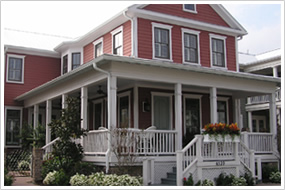 When most people think about housing trends, they think about wall colors, cabinet styles and materials. As lives become more complicated, priorities shift and the definition of family has changed significantly. In response to these shifts in society, the housing trends change and adapt. The economic situation for many homeowners has also caused adjustment to future housing plans.
When most people think about housing trends, they think about wall colors, cabinet styles and materials. As lives become more complicated, priorities shift and the definition of family has changed significantly. In response to these shifts in society, the housing trends change and adapt. The economic situation for many homeowners has also caused adjustment to future housing plans.
Location, Location, Location! Yes this has always been the most important aspect of choosing a home. In the past, people focused on a location because of family, job or cost of living. Now the number one priority in regards to location comes down to the walkability of restaurants, shopping and services.
We are all familiar with “green” building however the shift to “well” building is right around the corner. “Well” building continues the avoidance of harmful materials and the highlight of water and energy conservation with a new focus on design that enhances the life of the occupants. “Biophilic” design involves window and door placement to strive for a seamlessness between the home and the great outdoors. Increasing natural light and adding LEDs with dimmers and colors that can be changed according to time of day or weather. The lighting can simulate circadian rhythms in the body to improve sleep patterns which in turn is a boost to your health. In similar terms, a “well” home is all about being healthy in your body and in your mind.
In one of our early posts, we discussed the ever growing sustainable movement which has thousands of yards adorned with edible landscaping, backyard chickens and even bee hives. Going a few steps farther is a new housing trend called “Agrihood”. These are planned communities with a “nod” to communal living. The idea is to incorporate farming into planned neighborhoods where homesites are larger, community gardens and livestock herds cover the common areas and neighbors work together maintaining the needs of the farm. You may even see community kitchens and dining rooms instead of tennis courts and pools. The shared work and “fruits of labor” create a sense of pride and connection between neighbors. We expect to see more of these communities popping up as the sustainable movement spreads.
Managing power usage continues to be a top concern for home owners. In addition to solar panels there has been a huge boost in the number of “smart homes” which help to manage usage by automatically adjusting heating/cooling settings and lighting to accommodate time of day as well as weather. Most of the “smart home” technology can be accessed and manipulated by a cell phone app.
Consumers are demanding low maintenance features and materials as they no longer want to spend their weekends mowing grass and painting the deck. The focus has shifted to materials and systems with a greater longevity and durability. A good example is hand built brick walls, they will last for centuries rather than just one owner. This goes along with the push to build structures to withstand severe weather. Many builders and homeowners are “opting to go beyond what is required” says Philadelphia developer Nino Cutrufello.
To further to the low maintenance push, folks are choosing to build smaller, more open floorplans. Including creative use of space and smaller bedrooms allow for overall smaller structures. Since the bedroom is typically where we spend the least amount of time it makes sense to make these rooms smaller. This also is the case for families housing multiple generations. Private entrances offer a feeling of separation and independence while still being cost effective and family oriented.
With such a shift in housing trends it will be interesting to see what effect if any these changes have on the resale market. We may start to see more and more renovations to retro fit homes for the “new style” of living.
Tags: Brunswick County Real Estate, Brunswick Forest, Brunswick Housing Market, Coastal Realty Connections, Compass Point, Hot Trends Brunswick County, Housing Trends, southport nc homes sale, Southport Realty, Southport Realty Companies, St. James Plantation, wilmington houses sale Posted by


